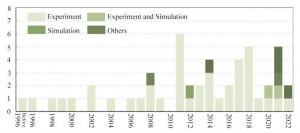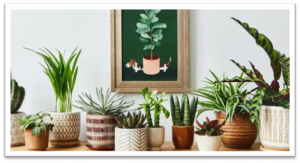Author: Legault Chloé
People are increasingly aware of air quality issues. Current popular issues relate to outdoor air pollution, which causes approximately 2.8 million deaths per year according to WHO. The lesser-known little brother of outdoor air pollution is indoor pollution; generally, indoor air pollution is 3x higher than outdoor air pollution! Which results in 14x more deaths than outdoor pollution… To reduce indoor pollution, a popular method is the use of indoor greenery. After all, the principle of photosynthesis is to capture CO2 and release oxygen. Thus, it is a popular belief that makes a lot of sense. But there’s more to this subject than meets the eye! Therefore, the objective of this blog is to demystify the impact of indoor plants on indoor air quality (IAQ).

1. Origin of the myth
Several studies have been done regarding the impact of indoor plants on IAQ in the past. The majority of research was through experimentation. The figure 1.1 shows the number and type of research performed.

Following the review of studies, plants are responsible for 3 phenomena impacting IAQ, namely:
- photosynthesis
- transpiration
- phytoremediation(Fudan, Lianyu, Xi, & Cen, 2022)
Photosynthesis is the process by which plants use light, water, and CO2 in the air to convert it into oxygen and sugar. The amount of light impacts the rate of photosynthesis. Transpiration is the evaporation of water emitted by the plant, mainly by the leaves. Transpiration therefore regulates the humidity levels and decreases the ambient temperature. Phytoremediation is the process by which plants remove various pollutants from their environment. Thus, they can act as a biological filter for total volatile compounds (TVC), CO, CO2, benzene, formaldehyde, etc. The rate of absorption varies according to the type of plant (Fudan, Lianyu, Xi, & Cen, 2022).
2. Demystifying the science
However, the conditions in inhabited buildings are very different from those in environments used for testing. Indeed, an inhabited space is generally more voluminous than the environments used for the tests, there is a constant contribution of VOC, as well as a constant exchange with the outdoor. Thus, subsequent studies considering inhabited environments have determined that a concentration of 10 to 1000 plants/m2 is necessary to obtain an air exchange like the normal exchange in a building. Thus, 680 plants would be necessary for a house of 140m2! This is obviously impossible (Cummings & Waring, 2019). Therefore, plants are only moderately effective in cleaning indoor air.
In addition, plants can also have a negative impact on IAQ, because of the respiration and the presence of bacteria and fungi. Indeed, sugar from photosynthesis is converted into energy during the process of cellular respiration. During the respiration process, plants emit CO2 and water vapor. The process of cellular respiration is continuously active, just like photosynthesis. Thus, during the night, a plant emits CO2. Approximately half of the CO2 absorbed during the day is emitted during the night (ABC News, 2022). Thus, putting plants in a room can affect the IAQ of residents at night. Besides, some type of plants have negative impacts on IAQ, specifically flowering potted plants and green walls. These plants are conducive to the growth of pathogenic fungi and bacteria. However, few studies on the aerosolization of pathogenic particles have been conducted. The types of bacteria and fungi vary with the type of plant. However, current studies ensure that the aerosolised fungal load is within the limits proposed by WHO (Torpy, et al., 2020).
There are significant differences in the ability to reduce pollutants depending on the type of plant. However, there is a lack of research to confidently conclude which plants are more effective ( (Fudan, Lianyu, Xi, & Cen, 2022). Research does, however, conclude that potted plants are more effective at reducing VOCs than crops in sand, clay balls, or rockwool (all hydroponics) (Burchett, Torpy, & Irga, 2013).
3. Then, what can they do?
Despite the mixed effectiveness of plants in improving IAQ. They have benefits on temperature and humidity regulation. They also have psychological benefits. Indeed, the presence of plants indoors helps reduce stress and anxiety (Yin, et al., 2020). It is also beneficial for patients in postoperative recovery. Studies have shown that patients who have plants in their rooms have a better response to pain, a better heart rate and blood pressure (Park & Mattson, 2008).

The addition of plants in buildings, may not have a big impact on the overall air quality, but it is a nice addition to the decoration and has a good psychological effect on us! So, open your windows to regulate the air quality and let your green thumb help you to relieve some stress.
Bibliography
ABC News. (2022, November 22). Plants release up to 30 per cent more CO2 than previously thought, study says. Récupéré sur ABC News: https://www.abc.net.au/news/2017-11-18/plant-respiration-co2-findings-anu-canberra/9163858
Burchett, M., Torpy, F., & Irga, P. (2013, October). Can hydroculture be used to enhance the performance of indoor plants for the removal of air pollutants? Récupéré sur Atmospheric Environment: https://www.sciencedirect.com/science/article/pii/S1352231013003427
Cummings, B. E., & Waring, M. S. (2019, November 06). Potted plants do not improve indoor air quality: a review and analysis of reported VOC removal efficiencies. Retrieved from Journal of Exposure Science & Environmental Epidemiology: https://www.nature.com/articles/s41370-019-0175-9
Fudan, L., Lianyu, Y., Xi, M., & Cen, Z. (2022, August 01). A review on indoor green plants employed to improve indoor environment. Retrieved from Journal of Building Engineering: https://www.sciencedirect.com/science/article/pii/S2352710222005551
Park, S.-H., & Mattson, R. H. (2008, Janvier). Effects of Flowering and Foliage Plants in Hospital Rooms on Patients Recovering from Abdominal Surgery. Retrieved from HorlTechnology: https://journals.ashs.org/horttech/view/journals/horttech/18/4/article-p563.xml
Torpy, F., Gill, R., Pettit, P., Irga, P., Williams, N., Seymour, J., & Fleck, R. (2020, July 15). Characterisation of fungal and bacterial dynamics in an active green wall used for indoor air pollutant removal. Retrieved from Building and Environment: https://www.sciencedirect.com/science/article/pii/S036013232030367X
Yin, J., Yuan, J., Arfaei, N., Catalano, P. J., Allen, J. G., & Spengler, J. D. (2020, March). Effects of biophilic indoor environment on stress and anxiety recovery: A between-subjects experiment in virtual reality. Retrieved from Environment International: https://www.sciencedirect.com/science/article/pii/S0160412019336347